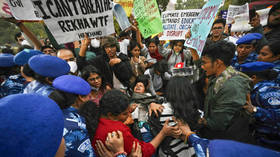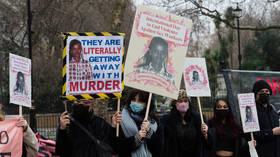Dozens detained in Indian capital for ‘clean air’ protests

A protest against the worsening air quality in the Indian capital led to the detention of dozens of people, who gathered to demand urgent government action on Sunday.
Residents of New Delhi, including environment activists and parents with children, gathered at India Gate, a war memorial in the center of the city, as pollution levels worsened to critical levels.
For the last fortnight, air quality in New Delhi has been identified as ‘poor’ to ‘severe’, making it the most polluted city in the country. By Monday, the air quality index stood at 344, which is considered ‘severe’ and dangerous to breathe, according to the World Health Organization.
“We want to meet our elected officials. We had sought an appointment with the chief minister but were refused. So many parents are here because their children are suffering,” environmentalist Bhavreen Khandari told NDTV, adding that “every third child already has damaged lungs.”
Another protester was quoted by NDTV as saying the government failed to provide the basic right “to breathe clean air” and that “politicians keep blaming each other instead of taking responsibility.”
#WATCH | Residents of Delhi protest at India Gate, demanding that the government formulate policies to curb air pollution in the National Capital region. pic.twitter.com/Iwxh2np3r5
— ANI (@ANI) November 9, 2025
Scene at India Gate. Despite, police warning , protesters continue to protest at India gate. #protestagainstpollutionpic.twitter.com/SSulNBqNlg
— Amit Pandey (@yuva_journalist) November 9, 2025
Protesters were seen holding placards and banners reading: “Breathing is killing me” and “I miss breathing.” Police asked the protesters to disperse. An officer quoted in the HT report said permission for the protest at India Gate had not been granted and that some individuals were detained.
Air quality in New Delhi deteriorates every winter as farmers in neighboring states burn crop residue, while cooler temperatures trap the smoke, blending it with emissions from vehicles and industries. Toxic particles persist due to the city’s dry, windless winters, occasionally raising pollution levels to 20 times above the WHO’s safe limit.











